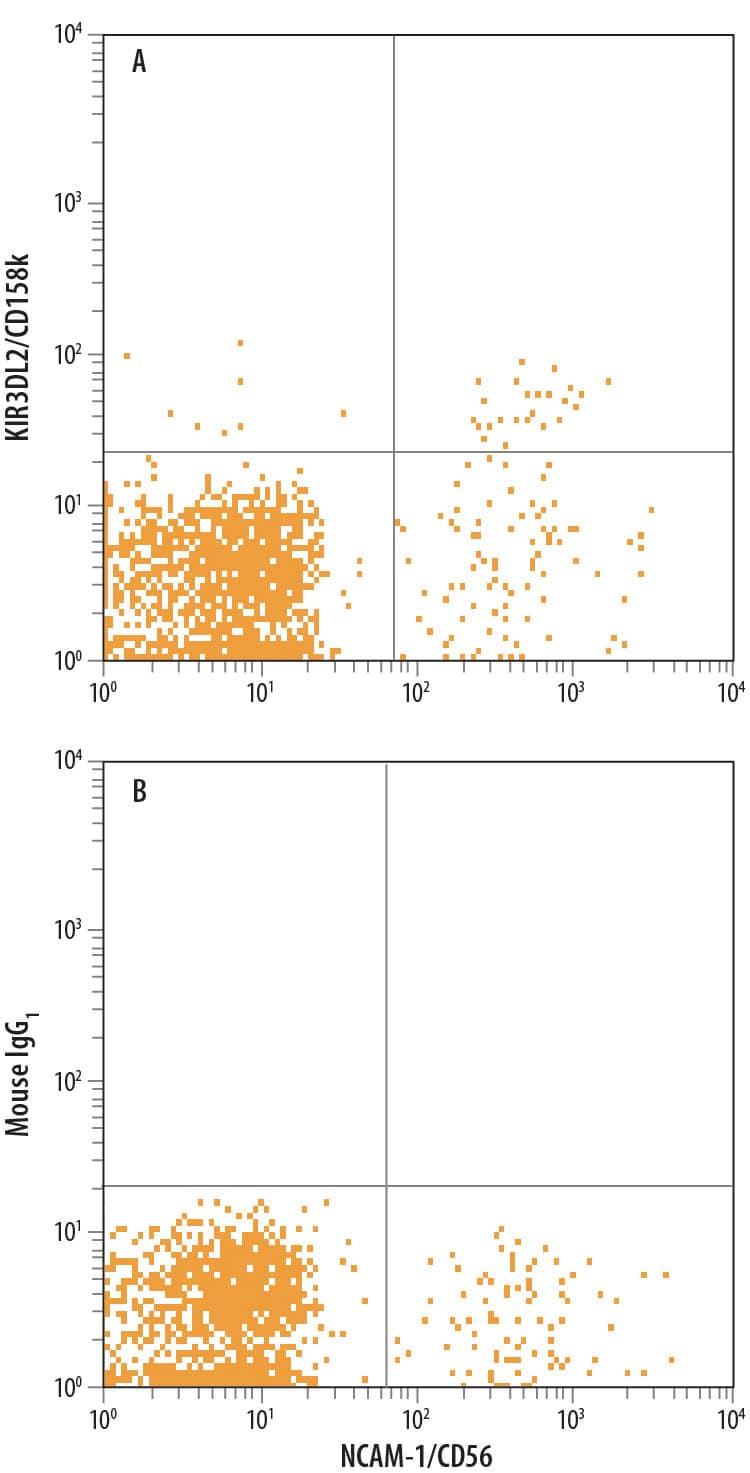Human KIR3DL2/CD158k APC-conjugated Antibody
R&D Systems, part of Bio-Techne | Catalog # FAB2878A


Conjugate
Catalog #
Key Product Details
Species Reactivity
Validated:
Human
Cited:
Human
Applications
Validated:
Flow Cytometry
Cited:
Flow Cytometry
Label
Allophycocyanin (Excitation = 620-650 nm, Emission = 660-670 nm)
Antibody Source
Monoclonal Mouse IgG1 Clone # 539304
Product Specifications
Immunogen
BaF3 mouse pro-B cell line transfected with human KIR3DL2/CD158k
Accession # P43630
Accession # P43630
Specificity
Detects human KIR3DL2/CD158k in direct ELISAs.
Clonality
Monoclonal
Host
Mouse
Isotype
IgG1
Scientific Data Images for Human KIR3DL2/CD158k APC-conjugated Antibody
Detection of KIR3DL2/CD158k in Human Blood Lymphocytes by Flow Cytometry.
Human peripheral blood lymphocytes were stained with Mouse Anti-Human NCAM-1/CD56 PE-conjugated Monoclonal Antibody (Catalog # FAB2408P) and either (A) Mouse Anti-Human KIR3DL2/CD158k APC-conjugated Monoclonal Antibody (Catalog # FAB2878A) or (B) Mouse IgG1Allophycocyanin Isotype Control (Catalog # IC002A). View our protocol for Staining Membrane-associated Proteins.Applications for Human KIR3DL2/CD158k APC-conjugated Antibody
Application
Recommended Usage
Flow Cytometry
10 µL/106 cells
Sample: Human peripheral blood lymphocytes
Sample: Human peripheral blood lymphocytes
Formulation, Preparation, and Storage
Purification
Protein A or G purified from hybridoma culture supernatant
Formulation
Supplied in a saline solution containing BSA and Sodium Azide.
Shipping
The product is shipped with polar packs. Upon receipt, store it immediately at the temperature recommended below.
Stability & Storage
Protect from light. Do not freeze.
- 12 months from date of receipt, 2 to 8 °C as supplied.
Background: KIR3DL2/CD158k
References
- Colonna, M. and J. Samaridis (1995) Science 268:405.
- Pende, D. et al. (1996) J. Exp. Med. 184:505.
- Lanier, L. L. (2005) Annu. Rev. Immunol. 23:225.
- Uhrberg, M. et al. (1997) Immunity 7:753.
- Meenaugh, A. et al. (2004) Tiss. Antigens 64:226.
- Kwon, D. et al. (2000) Mol. Cells 10:54.
- Dohring, C. et al. (1996) J. Immunol. 156:3098.
- Hansasuta, P. et al. (2004) Eur. J. Immunol. 34:1673.
- Kollnberger, S. et al. (2002) Arthritis Rheum. 46:2972.
- Chan, A. T. et al. (2005) Arthritis Rheum. 52:3586.
- Poszepczynska-Guigne, E. et al. (2004) J. Invest. Dermatol. 122:820.
Long Name
Killer Cell Immunoglobulin-like Receptor, Three Domain Long Cytoplasmic Tail, 2
Alternate Names
CD158k, CL-5, NKAT4A, NKAT4B
Gene Symbol
KIR3DL2
UniProt
Additional KIR3DL2/CD158k Products
Product Documents for Human KIR3DL2/CD158k APC-conjugated Antibody
Product Specific Notices for Human KIR3DL2/CD158k APC-conjugated Antibody
For research use only
